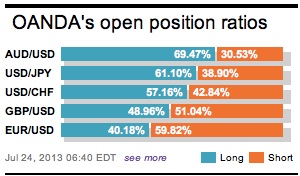Is the Euro-zone exiting recession? The 17-member single currency has managed to jump to a one month high outright this morning. Euro bourses are in the ‘black’ and German short-term yields are backing up after data from two of the regions largest economies show signs of growth.
A preliminary reading of 50.4 on the Euro-zones composite (manufacturing and services) Purchasing Managers Index for this month was higher than expected (49.3). This is the first piece of conclusive evidence that the region is potentially returning to growth for the first time since January of this year. Up until now the EUR had been underpinned by a significant improvement in yield spreads and by capital repatriation from a deleveraging banking sector. Any fresh deterioration in the Euro-zone PMI indices would have immediately damaged the single currency’s yield support. An individual reading from France and Germany, considered the backbone of Europe, was particularly strong.

Today’s better than expected manufacturing PMI figures, particularly from France (49.8) and Germany (50.3), clearly supports the market notion that the Euro-zone as a whole is potentially leaving the recession behind in the third quarter. However, any recovery is still expected to be fragile. What’s impressive is that the Euro improvements in the manufacturing data comes against a backdrop of record high unemployment, credit supply concerns and ongoing austerity measures being implemented, especially by peripheral governments. The revival is being led by a broad based upturn in manufacturing – increased goods production was reported especially in Germany and France. This mornings survey is encouraging evidence that the region could be pulling out of its recession in the Q3.

The same cannot be said for China. The HSBC’s preliminary PMI for the world’s second largest economy was reported lower (47.7) than expected (48.2). Currency’s that have strong trading links with the country, like the AUD for instance, have come under renewed pressure along with the local bourses as investors again are reminded that not all is well in the world’s second largest economy. The market is lucky, a negative move by risk assets could have been more pronounced, but only for the fact that Beijing has been speaking with a stronger pro-stimulus tone of late (liberalization of rates). However, more is needed and Chinese policy makers will have to reach a consensus and initiate further mild pro-growth measures to stem economic slowdown.
The market turmoil witnessed by Capital Markets over the past month has somewhat receded, especially after ‘Helicopter’ Ben’s testimony last week where he seemed to have stepped back from reducing stimulus for the time being. His decision was certainly made a tad easier after the weaker than anticipated US housing data over the past few weeks. The market has been trading on the premise that following US yields will lead you to a truer dollar value.
The market will try and trade lightly for the remainder of the summer, however, this may not be possible. US 10’s have retraced close to -23bps from this month’s high of 2.74% peak recorded in the first week. Higher yields favor a stronger USD. Since Ben has corked the “tapering bottle” the dollars TWI has fallen -1.7%. Event risk comes fast and furious over what remains of this summer. Yes, these markets will be thin, but prices should not be expected to remain close to home. The market expects light trading, but with next week’s FOMC meet, participants will be reminded that the possibility of tapering commencing within a matter of weeks should have the various asset classes trying to price accordingly. Market participants will not be waiting for Europe to come back from their annual leave, as the opportunity cost of doing noting is too great.

The US-German yield gap remains a pivotal market relationship and is a very strong determinant of currency values. It is no coincidence that the Euro has strengthened as the yield gap has narrowed. The EUR has managed to print a one-month high so far this morning (1.3255). Will the Stateside session continue to provide momentum support?
So far there has been little pull back post PMI highs, a good sign for the 17-member currency. The problem is that many strategies look rather similar – this market has wanted to offload EUR’s on rallies all week. So far, real money has been selling the highs backed up by further single currency offers in the 1.3260-80 range. What is interesting is that the spec buyers have shifted their bids higher to north of 1.3200. In the grander scheme of things this market still remains negative towards the EUR – proven by the quick short squeeze after the Euro-PMI results this morning.

Other Links:
Dollar Direction Needs Data Not Just Event Risk
Dean Popplewell, Director of Currency Analysis and Research @ OANDA MarketPulseFX
This article is for general information purposes only. It is not investment advice or a solution to buy or sell securities. Opinions are the authors; not necessarily that of OANDA Corporation or any of its affiliates, subsidiaries, officers or directors. Leveraged trading is high risk and not suitable for all. You could lose all of your deposited funds.


